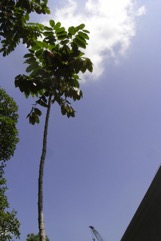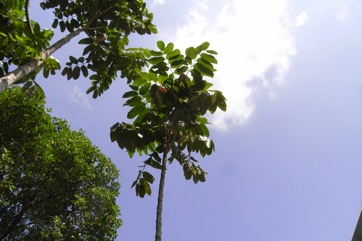Borneo olive, Sibu olive

A tropical plant. It grows in forests from sea level to 450 m altitude. It can be in swamps and along rivers.
Also known as:
Bundui-bundui, Dabai, Dabang, Dabu, Danau majang, Dawai, Kambayau, Kembayau, Kumbayan, Kurihang, Saluan
Synonyms
- Canarium beccarii Engl.
- Canarium multifidum H. J. Lam.
- Canarium palawanense Elm.
Edible Portion
- Fruit, Kernel, Nuts, Seed
Where does Borneo olive grow?
Found in: Asia, Australia, Brunei, Indonesia, Malaysia, Sarawak, Pacific, Philippines, SE Asia
Notes: There are 80-95 Canarium species. The fruit is high in oil content.
Status: It is widely cultivated in Sarawak for its edible fruit.
Growing Borneo olive, Sibu olive
Cultivation: When grown from seed, 70% or the trees are male.
Edible Uses: The blue-black fruit are eaten raw. For eating fresh they are soaked in hot water for 10 minutes until softened and eaten with soy sauce or as a snack. The kernel is also eaten.
Production: Flowering is from March to April and September to October and fruiting from May to November. Fruit can only be kept for 2-3 days after harvesting. The fruit are put into hot water to soften.
Nutrition Info
per 100g edible portion| Edible Part | Energy (kcal) | Protein (g) | Iron (mg) | Vitamin A (ug) | Vitamin c (mg) | Zinc (mg) | % Water |
|---|---|---|---|---|---|---|---|
| Fruit | 339 | 3.8 | 1.3 | - | - | 4.7 | 41.3 |
| Nuts | - | 9 | - | - | - | - | 35 |
Borneo olive, Sibu olive Photos


References
Altschul, S.V.R., 1973, Drugs and Foods from Little-known Plants. Notes in Harvard University Herbaria. Harvard Univ. Press. Massachusetts. no. 1979
Chai, P. P. K. (Ed), et al, 2000, A checklist of Flora, Fauna, Food and Medicinal Plants. Lanjak Entimau Wildlife Sanctuary, Sarawak. Forestry Malaysia & ITTO. p 166
Chua, H. P., et al, 2015, Physical properties and nutritional values of dabai fruit (Canarium odontophyllum) of different genotypes. J. Trop. Agric. and Fd. Sc. 43(1)p 1-10
Ding, P. and Tee, Y. K., 2011, Physicochemical characteristics of dabai (Canarium odontophyllum Miq.) fruit. Fruits, Vol 66. p 47-52
Facciola, S., 1998, Cornucopia 2: a Source Book of Edible Plants. Kampong Publications, p 62
Fl. Ned. Ind., Eerste bijv. 525. 1861
Hoe, V. B. & Siong, K. H., 1999, The nutritional value of indigenous fruit and vegetables in Sarawak. Asia Pacific J. Clin. Nutr. 8(1):24-31
Leenhouts, P.W., 1955, Burseraceae in Flora Malesiana 5(1) p 272
Milow, P., et al, 2013, Malaysian species of plants with edible fruits or seeds and their evaluation. International Journal of Fruit Science. 14:1, 1-27
Siong, K. H., 2003, Indigenous Fruits of Sarawak. ITTO & Sarawak Forest Department. p 34
Slik, F., www.asianplant.net
Soepadmo, E. and Wong, K. M., 1995, Tree Flora of Sabah and Sarawak. Forestry Malaysia. Volume One. p 59
Tanaka,
Tankard, G., 1990, Tropical fruit. An Australian Guide to Growing and using exotic fruit. Viking p 127
USDA, ARS, National Genetic Resources Program. Germplasm Resources Information Network - (GRIN). [Online Database] National Germplasm Resources Laboratory, Beltsville, Maryland. Available: www.ars-grin.gov/cgi-bin/npgs/html/econ.pl (10 April 2000)
World Checklist of Useful Plant Species 2020. Royal Botanic Gardens, Kew